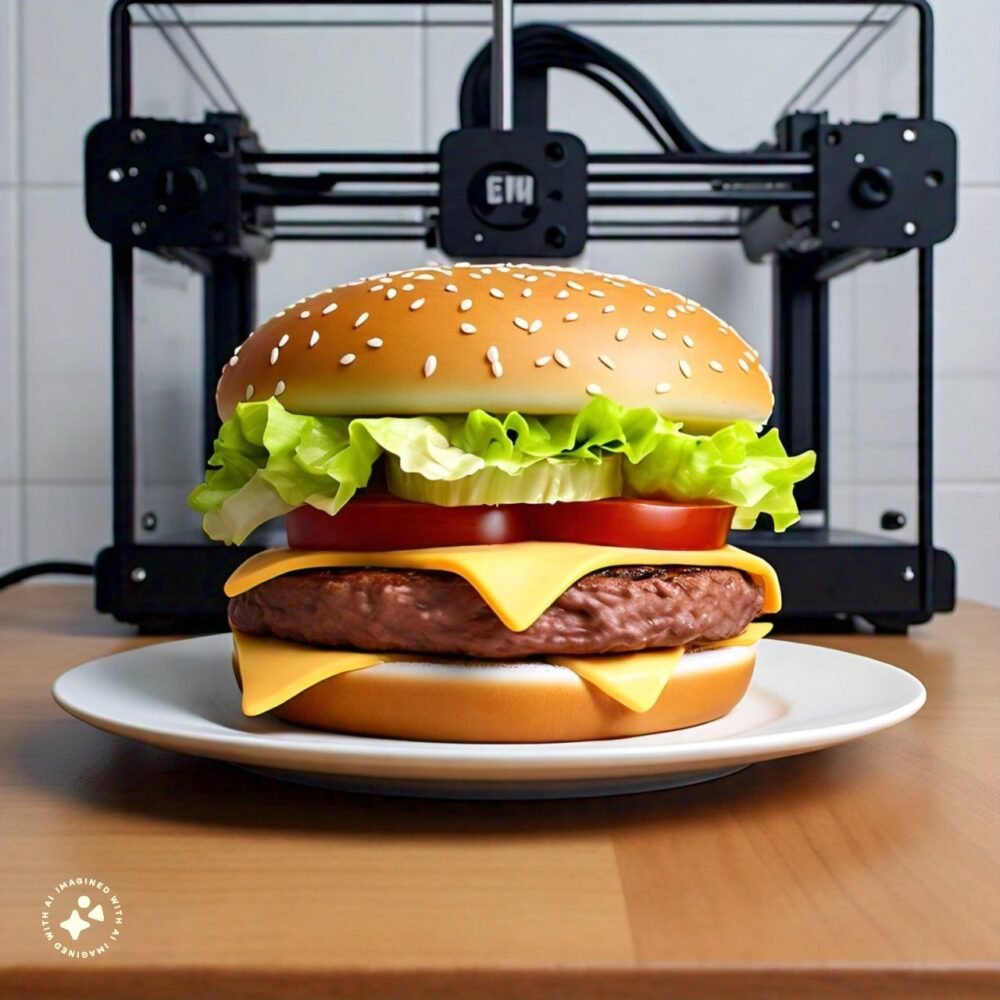3D printing, also known as additive manufacturing, has revolutionized various industries, including healthcare, automotive, and aerospace. More recently, this technology has entered the domain of food production, offering innovative ways to prepare and present food. 3D printing of food items is not just a novelty but has practical applications that can transform how we approach cooking, nutrition, and food sustainability. This article explores the current state of 3D food printing, its potential benefits, challenges, and future prospects.

Key Takeaways
- Innovative Applications: 3D printing in food can create customized nutrition, intricate designs, and sustainable alternatives.
- Health and Nutrition: Personalized meals tailored to individual dietary needs can improve overall health.
- Challenges: High costs, technological limitations, and regulatory hurdles need to be addressed for widespread adoption.
- Future Prospects: Advancements in technology and materials will likely make 3D food printing more accessible and practical.
The Technology Behind 3D Food Printing
How 3D Food Printing Works
3D food printing involves the layer-by-layer deposition of food ingredients to create a final product based on a digital design. Here is a step-by-step explanation of the process:
- Design Creation: The process begins with creating a digital model of the food item using computer-aided design (CAD) software. This design can range from simple shapes to intricate and complex structures.
- Preparation of Ingredients: Food materials are prepared in a suitable form for printing. This often involves converting ingredients into purees, pastes, or gels that can be easily extruded through the printer’s nozzle.
- Slicing the Design: The digital model is then sliced into thin horizontal layers using slicing software. This step translates the 3D model into a series of 2D layers, which the printer will use to construct the final product.
- Printing: The 3D food printer deposits the prepared food materials layer by layer according to the sliced design. This can involve multiple print heads or nozzles for different ingredients to create multi-component food items.
- Post-Processing: After printing, some food items may require additional steps such as baking, cooling, or garnishing to achieve the desired texture, flavor, and appearance.
Types of 3D Food Printers
There are several types of 3D food printers, each using different techniques suited to various applications and food materials:
- Extrusion-Based Printers:
- Mechanism: These printers use a syringe-like mechanism to extrude food pastes or purees through a nozzle.
- Applications: Suitable for a wide range of foods, including doughs, chocolate, cheese, and mashed vegetables.
- Advantages: Versatile and capable of handling multiple types of food materials.
- Inkjet Printers:
- Mechanism: Utilize droplets of food-grade inks to create designs or add colors to the surface of food items.
- Applications: Commonly used for decorating cakes, cookies, and other baked goods.
- Advantages: Excellent for detailed and intricate designs with vibrant colors.
- Binder Jetting:
- Mechanism: Involves depositing a liquid binder onto a bed of powdered food material, binding the powder layer by layer to form a solid structure.
- Applications: Used for creating complex shapes and structures from powdered ingredients such as sugar, chocolate, or dough.
- Advantages: Capable of producing detailed and complex geometries.
- Selective Laser Sintering (SLS):
- Mechanism: Uses a laser to sinter powdered food materials, fusing them into solid structures layer by layer.
- Applications: Experimental use in creating detailed and precise shapes from powdered chocolate and other materials.
- Advantages: High precision and ability to create intricate designs.
Materials Used in 3D Food Printing
The choice of materials is crucial for successful 3D food printing. Commonly used food materials include:
- Chocolate: Popular for creating intricate designs and decorations.
- Doughs and Batters: Used for printing breads, pastries, and other baked goods.
- Purees and Pastes: Vegetable, fruit, and protein pastes are used for a variety of savory and sweet dishes.
- Gels and Hydrocolloids: Such as agar-agar and gelatin, used to create stable and structured forms.
- Powders: Ingredients like sugar, cocoa, and flour are used in binder jetting and SLS printers.
Innovative Applications of 3D Food Printing
Customized Nutrition
One of the most significant advantages of 3D food printing is the ability to create meals tailored to specific nutritional needs. This can be particularly beneficial in healthcare settings, where patients may have unique dietary requirements. For example, a patient with difficulty swallowing can receive meals that are nutritionally balanced but in a form that is easy to consume.
Intricate Designs and Novelty Foods
3D printing allows for the creation of complex and intricate food designs that would be impossible to achieve with traditional cooking methods. This capability is highly appealing in the culinary arts, enabling chefs to experiment with new textures, shapes, and presentations. Novelty foods, such as personalized chocolates or candies, can be printed with precise details, making them unique and visually appealing.
Sustainable Food Production
3D food printing can also contribute to sustainability in food production. 3D printing can reduce the environmental impact of food production. Additionally, this technology can help minimize food waste by utilizing ingredients that would otherwise be discarded.
Health and Nutrition Benefits
3D food printing has the potential to revolutionize how we approach health and nutrition. Personalized nutrition is a growing field, and 3D printing can play a crucial role in this development. By analyzing an individual’s dietary needs and health conditions, 3D food printers can produce meals that are optimized for their nutritional requirements.
For instance, elderly individuals who need a higher intake of certain vitamins and minerals can receive meals specifically designed to meet those needs. Athletes can benefit from meals that provide the right balance of proteins, carbohydrates, and fats to enhance performance and recovery. Moreover, 3D food printing can help manage chronic conditions such as diabetes by providing meals with controlled sugar and carbohydrate content.
Challenges and Limitations
Despite its promising potential, 3D food printing faces several challenges that need to be addressed before it can become mainstream.
High Costs
The cost of 3D food printers and the ingredients used can be prohibitively high for both consumers and businesses. This limits the accessibility of the technology and restricts its use to niche markets and high-end restaurants.
Technological Limitations
Current 3D food printers have limitations in terms of the types of ingredients they can use and the complexity of the structures they can create. The texture and consistency of the printed food can also be a challenge, as achieving the right mouthfeel and taste is crucial for consumer acceptance.
Regulatory and Safety Concerns
Food safety is a critical issue when it comes to 3D printed food. Ensuring that the printers and materials used meet strict hygiene and safety standards is essential. Additionally, there are regulatory hurdles that need to be overcome, as existing food safety regulations may not adequately cover the new technology.
Future Prospects
The future of 3D food printing looks promising, with ongoing research and development aimed at overcoming current challenges. As technology advances, the cost of 3D printers is expected to decrease, making them more accessible to a broader audience. Improvements in printer capabilities and materials will enable more complex and diverse food creations.
Integration with Smart Kitchens
The integration of 3D food printers with smart kitchen appliances could revolutionize home cooking. Imagine a kitchen where your refrigerator, stove, and 3D printer communicate seamlessly to prepare a meal tailored to your dietary needs and preferences. This level of automation and personalization could make healthy eating more convenient and enjoyable.
Educational and Cooking Innovations
3D food printing also has the potential to become a valuable tool in education and culinary arts. It can be used to teach students about nutrition, food science, and technology, providing a hands-on learning experience. In professional kitchens, chefs can push the boundaries of creativity, experimenting with new flavors, textures, and presentations.
Addressing Global Food Challenges
In the long term, 3D food printing could play a role in addressing global food challenges such as hunger and malnutrition. By using alternative and sustainable ingredients, and by enabling precise nutrient delivery, this technology could help provide nutritious food to underserved populations.
Conclusion
3D printing of food items represents a fascinating intersection of technology, culinary arts, and nutrition. While there are significant challenges to overcome, the potential benefits are immense. From personalized nutrition and sustainable food production to innovative cooking creations, 3D food printing is assured to transform how we think about food. As the technology continues to evolve, it will likely become an integral part of our kitchens, restaurants, and food systems, offering new possibilities for health, creativity, and sustainability.




Leave a Reply